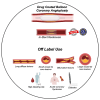Drug-Coated Balloons for Coronary Interventions: A Focused Review
- PMID: 40822373
- PMCID: PMC12352407
- DOI: 10.14797/mdcvj.1607
Drug-Coated Balloons for Coronary Interventions: A Focused Review
Abstract
The development of catheter-based interventions has revolutionized the treatment of coronary artery disease (CAD), from the first heart catheterization in 1929 to the emergence of drug-coated balloons (DCBs) as a treatment for in-stent restenosis (ISR). This review explores the evolution and clinical application of DCBs in CAD, with a particular focus on their role in managing ISR, de novo coronary disease, and complex lesions. DCBs deliver antiproliferative drugs such as paclitaxel or sirolimus to the vessel wall and have emerged as a promising alternative to traditional stent-based therapies, reducing the need for permanent metallic implants and associated thrombotic risks. Early research demonstrated the effectiveness of DCBs in ISR, and recent studies have expanded their application to small vessel disease, bifurcation lesions, and long diffuse lesions. Notably, DCBs have shown non-inferiority to drug-eluting stents in certain cases, including high-risk patients and those with complex coronary anatomy. Despite some challenges, such as the potential for coronary dissection and the need for optimal lesion preparation, DCBs have demonstrated strong potential in reducing restenosis and improving long-term outcomes in a variety of patient populations. While further studies are required to refine their use in off-label indications, DCBs may represent a versatile, effective, and safer approach in the management of CAD.
Keywords: coronary artery disease; drug-coated balloon; in-stent restenosis; interventional cardiology; percutaneous coronary intervention.
Copyright: © 2025 The Author(s).
Conflict of interest statement
The authors have no competing interests to declare.
Figures







References
-
- Forssmann W. Die sondierung des rechten herzens. Klinische Wochenschrift. 1929;8:2085-2087. doi: 10.1007/BF01875120 - DOI
-
- Puel J, Joffre F, Rousseau H, Guermonprez J, Lancelin B, Morice M. [Self-expanding coronary endoprosthesis in the prevention of restenosis following transluminal angioplasty. Preliminary clinical study]. Arch Mal Coeur Vaiss. 1987. Jul;80(8):1311-2. PMID: 2961318 - PubMed
Publication types
MeSH terms
Substances
LinkOut - more resources
Full Text Sources
Medical
Miscellaneous

